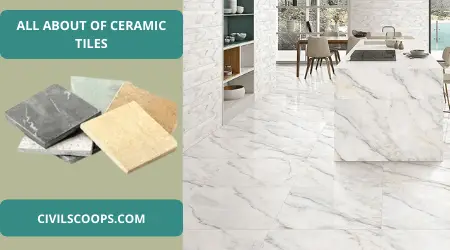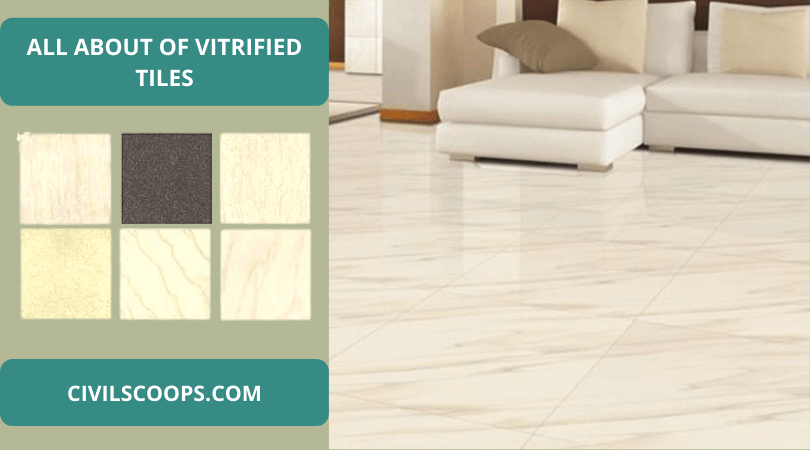What Is Ceramic Tiles? | Advantages & Disadvantages of Ceramic Tiles | What Is Vitrified Tiles? | Advantages & Disadvantages Vitrified Tiles | Differences Between Ceramic Tiles and Vitrified Tiles

Table of Contents
Introduction of Ceramic and Vitrified Tiles:
What Is Ceramic Tiles?

Ceramic is a term that is used to refer to all types of natural soil or clay. Ceramic tiles are composed of minerals, clay, and other solvents. Ceramic refers to a certain range of things – ceramic tiles, cutlery, inlay for teeth, decorative fine art, etc. These ceramics are heated at high temperatures and are resistant to force and stains.
What Is Vitrified Tiles?

Vitrified tiles are made from 60% silica and 40% clay. Vitrified tiles are also a type of ceramic tiles that are made by heating the mixture or setting it under high temperatures. Vitrified tiles acquire a glass-like texture in the process. Low porosity, Longevity, low maintenance, and scratch resistance are some of the visible characteristics of vitrified tiles.
Difference Between Ceramic Tiles and Vitrified Tiles:
Ceramic Tiles VS Vitrified Tiles: Composition
- Composition of Ceramics tiles: The Ceramics tiles are made by using earthen soil or clay.
- Composition of Vitrified tiles: The Vitrified tiles are made from a mixture of different materials such as silica, quartz, and feldspar with clay.
Ceramic Tiles VS Vitrified Tiles: Uses
- Uses of Ceramics tiles: Ceramics tiles are often used for floors, walls, backsplashes, and countertops. Ceramic tiles are commonly used in wet areas such as bathrooms and kitchens.
- Uses of Vitrified tiles: Vitrified tiles are a good choice as flooring in residential building, commercial areas and residency.
Also Read: What Is Lintel? | Function of Lintel | Types of Lintel
Ceramic Tiles VS Vitrified Tiles: Advantages
- Advantage of Ceramics tiles: Ceramic tiles are very easy to maintain. Soap and hot water work best to remove dirt and grime from Ceramic tiles. For hard stains, reinforcing agents can be used without fear of damage to the Ceramic tiles.
- Ceramic tiles provide endless design options. Ceramic tiles can be made in to different types of colours, shapes, sizes, patterns, and textures.
- Advantage of Vitrified tiles: Vitrified tiles are rigid, virtually non-porous and impermeable to stains and scratches, making them ideal outside the home as well.
- The Vitrified tiles is given a uniform colour before discarding the dye added to the soil, so that the colour will remain the same even when the tile is scratched.
- Vitrified tiles can be used within 48 hours of laying, as they require practically no setting time or polishing.
Ceramic Tiles VS Vitrified Tiles: Disadvantage
- Disadvantage of Ceramics tiles: Grout lines are difficult to maintain. While the Ceramic tiles themselves are low-maintenance, grout lines require sealing to avoid moisture and mildew (but after sometimes latter it is managed with some amount of vinegar and water mixture) from seeping inside.
- Ceramic tiles are not the best choice for flooring in cold climates. Ceramic tiles can be very cold in winter, making bare feet extremely unpleasant.
- Direct sunlight can fade colours over time for Ceramic tiles.
- Disadvantage of Vitrified tiles: Vitrified tiles installation word is a very difficult work and it requires more experienced labours, as the tiles need to laid even in nature, with a little noticeable joints. Vitrified tiles sometimes also require a stronger adhesive than ceramic tiles to join with each other, this type of installation is more expensive than the previous one.
- Glossy vitrified tiles (as opposed to matte ones) can be extremely slippery when wet.
- Vitrified tiles are not environmentally friendly because the process of making vitrified tiles is heavy use of energy consumption and it produces more carbon dioxide.
Also Read: Density of Cement Sand and Aggregate | Density of Cement | Density of Sand | Density of Aggregate
Ceramic Tiles VS Vitrified Tiles: Properties
- Properties of Ceramics tiles: Ceramic tiles are thicker in texture than vitrified tiles, which are known for their shiny and glassy look. But also, ceramic tiles have a more attractive, natural and earthy texture than vitrified tiles, with an attractive texture giving an artificial touch
- Ceramic tiles are made of natural clay which is mixed with water and then baked in a kiln. Ceramic tiles have a natural, earthy look, come in various colours and sizes, and are most often shined or glazed for protection from water, stains and scratches.
- Ceramic tiles are rarely used in their unglazed form. The rigid protective layer provided by the glaze makes Ceramic tiles a good bet for floors, walls, backsplashes, and countertops. Ceramic tiles are commonly used in wet areas such as bathrooms and kitchens, as Ceramic tiles are water resistant, easier to clean and less prone to breading germ.
- Properties of Vitrified tiles: Vitrified tiles are stronger than ceramic tiles due to the process of vitrification. Since Vitrified tiles are made from a mixture of different materials such as silica, quartz, and feldspar with clay, baking at high temperatures fuses them together to make makes vitrified tiles are more durable in nature and also have good resistant property.
- Vitrified tiles have low porosity, so it absorbs less water than ceramic tiles. This property creates vitrified tiles a good choice in residential building for flooring.
- Vitrified tiles are highly scratch and stain resistant property than ceramic tiles due to their material composition.
- Vitrified tiles are almost similar to ceramic tiles -the main difference is that clay is fired into a kiln with silica, quartz, and feldspar. These additional elements, when baked at high temperatures, fuse together, which is shiny and hard. A vitrified tile gets its name from the process of manufacturing, which is termed as virtification.
- Vitrified tiles are a less expensive alternative to natural stone such as marble and granite, while providing similar appearance and better durability. This makes Vitrified tiles a good choice for residency.
Ceramic Tiles VS Vitrified Tiles: Installing
- Installing of Ceramic tiles: The installation is simple and easier than vitrified tiles. It needs a less qualified worker for installation.
- Ceramic tiles are easy to replace. If one tile (or several) is damaged, they can be replaced or changed easily.
- Installing of Vitrified tiles: The installation is complicated and harder than ceramic tiles. It needs a trained worker for installation.
Ceramic Tiles VS Vitrified Tiles: Maintenance & Service
- Maintenance & Service of Ceramics tiles: Ceramic tiles themselves are low-maintenance, grout lines require sealing to avoid moisture and mildew (but after sometimes latter it is managed with some amount of vinegar and water mixture) from seeping inside.
- Maintenance & Service of Vitrified tiles: Vitrified tiles are extremely durable in nature and it requires low maintenance cost, those properties are making that type of tiles ideal and perfect for high-traffic areas. This is the reason of Vitrified tiles are used widely in commercial areas.
Ceramic Tiles VS Vitrified Tiles: Size
- Size of Ceramics tiles: Ceramic tiles are restricted in size. Ceramic tiles rarely come in large size, size larger than 12 inches x 12 inches are rarely seen in market.
- Size of Vitrified tiles: Vitrified tiles are available in larger sizes in the market, so the number of joints is less.
Ceramic Tiles VS Vitrified Tiles: Expenses
- Expenses of Ceramic tiles: Ceramic tiles are cost effective. Ceramic tiles are relatively inexpensive compared to other types of tiles.
- Expenses of Vitrified tiles: Vitrified tiles, they are priced higher than ceramic tiles.
- Vitrified tiles are little bit expensive than ceramic tiles due to their additional properties.
Ceramic Tiles VS Vitrified Tiles: Manufacturers
- Manufacturers of Ceramic tiles: Ceramics tiles are manufactured by Kajaria Ceramics Limited, Somany Ceramics, NITCO Limited, Orientbell Limited and Asian Granito India Limited.
- Manufacturers of Vitrified tiles: Vitrified tiles are manufactured by Kajaria Ceramics Limited, Somany Ceramics, NITCO Limited, Simpolo Ceramics Limited and Varmora Ceramics Limited.
[note note_color=”#F2F2F2 ” text_color=”#333333″ radius=”3″ class=”” id=””]
Like this post? Share it with your friends!
Suggested Read –
- What Is Gable Roof | History of Gable Roofing | Gable Roof Design | Parts of Gable Roof | Types of Gable Roofs | How Long Can the Roof Last? | Gable Roof Advantages and Disadvantages | Cost of Gable Roof Construction |
- Building Layout | How to Building Layout | Construction Layout Techniques
- How a Building Is Constructed | Components of Building
- What Is Bituminous Road? | Bituminous Road Construction | Bituminous Road Layers | Bituminous Macadam | Bituminous Road Construction Process | Advantages of Bitumen Road | Disadvantages of Bitumen Road | Application Road
- What Is Super Elevation? | Superelevation Definition | Purpose of Providing Superelevation in Roads | Calculation of Superelevation in Roads | Minimum and Maximum Superelevation in Roads | Method of Providing Superelevation to the Roads
[/note]
Originally posted 2021-08-13 06:12:59.
